|

| |
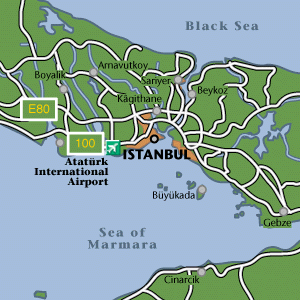 |
We visited Istanbul in May 2002 over a 3 day weekend.
The weather was excellent and we had a great time just skimming the surface of
this imperial city and making plans for a more substantial visit. We
toured several of the major monuments, took a boat trip up the Bosphorus,
and walked through the Bazaars and markets extensively, while the children
took first hand lessons in street vendor selling and negotiating. All
very eye opening but lots of fun after a bit.
Istanbul taxis are pretty aggressive, using horns simply to notify cars in
other lanes that "we are coming..."... One of the most interesting
facets of driving in Istanbul is the traffic light with a large timer on
top; the timer illustrates a 30 second countdown before the Red light turns
Green, and Green to Red. Drivers begin rev'ving their engines 15
seconds before the Green... and off they go. We blasted through 30 KPH
sections of road at 80 kph, then 20 KPH at 80KPH, then even a 10KPH section
of road. Thrilling...
Another great memory is the call to prayer that each
mosque makes 5 times a day. We've heard this before in Jordan, but it
is quite special in Istanbul, as with hundreds of mosques the call (each
mosque is a bit different) echo's from many points all over the city, each
beginning and ending slightly off from each other, and each with a different
caller. Very haunting and special. |
| The Aya Sofya (Hagia Sophia in Greek) is
in the background. This church was the greatest in Christendom when
built in 532AD by Emperor Justiniun. The interior dome is 43 meters
high, and butresses were not used (they were added later, along with the
minarets, by the Ottoman Turkish conquerors after 1453 AD). Great
mosaic pictures from 300-550 AD. Justiniun is pictured on the left,
offering the church of Saint Sophia to Mary and the Christ Child. The
ceiling picture shows the original Byzantine art, left preserved by the
Ottomans as it did not show images. The Ottoman moslems only covered
up the images with plaster, and put up the great plaques with Allah's name
on it, deliberately trying to retain the architectural and artistic
integrity of Saint Sophia. The single brick minaret was the first,
built by Mehmet, who used brick to remain consistent with the Byzantine
style. The other minarets were constructed of marble by subsequent
sultans. |




 |
| Emilie growing up!
The Blue Mosque was built in the 1600's by the Islamic
Sultan to be greater than St. Sophia, and is quite beautifully lined with
blue tiles inside, and with wonderful oriental carpets completely covering
the floor. |
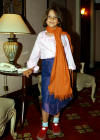


 |
| Emperor Justiniun built several massive
underground cisterns to hold water; this is the largest that survives; it
holds 20 million gallons of water, has 363 columns supporting the roof, with
walls 12 feet thick, and was built in 360 AD! By the way, if you
remember the scene in From Russia with Love, James Bond boats along these
waters... A picture of Sara and the kids in the
Grand Bazaar; we had fun - after 3 visits you relax and learn to enjoy the
hard sell and bargaining.
One of multitude of "tour" boats on the Bosphorus.
Istanbul has hundreds of mosques; during the Byzantine
empire there were rumoured to be 4000 churches (many small of course).
The few defenders that surrendered immediately were allowed to live and
retain their churches, but the vast majority were killed in battle or
afterwards, and the churches converted to mosques.
The fortress was built by Mehmet in 1452 to block the
Bosphorus and prevent the reinforcement of Constantinople a year before he
conquered the city... Great transfiguration of very old, very new.
The bridges connect Europe and Asia. |
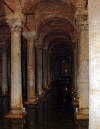




 |
- Our hotel, the Four Seasons, was the Murderers
Prison until 1995. Very thick walls and a picturesque moat-wall!
A Postcard place to stay, and fantastically set directly among the major
sights.
- Sara relaxing after lunch. Derek doing
same... Emilie doing same!
- Sara & kids in Yenekoy, on the Bosphorus where the
summer houses line the shores.
|

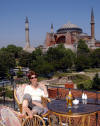
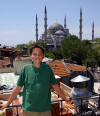

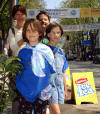 |
| |
|
| |
|
|
